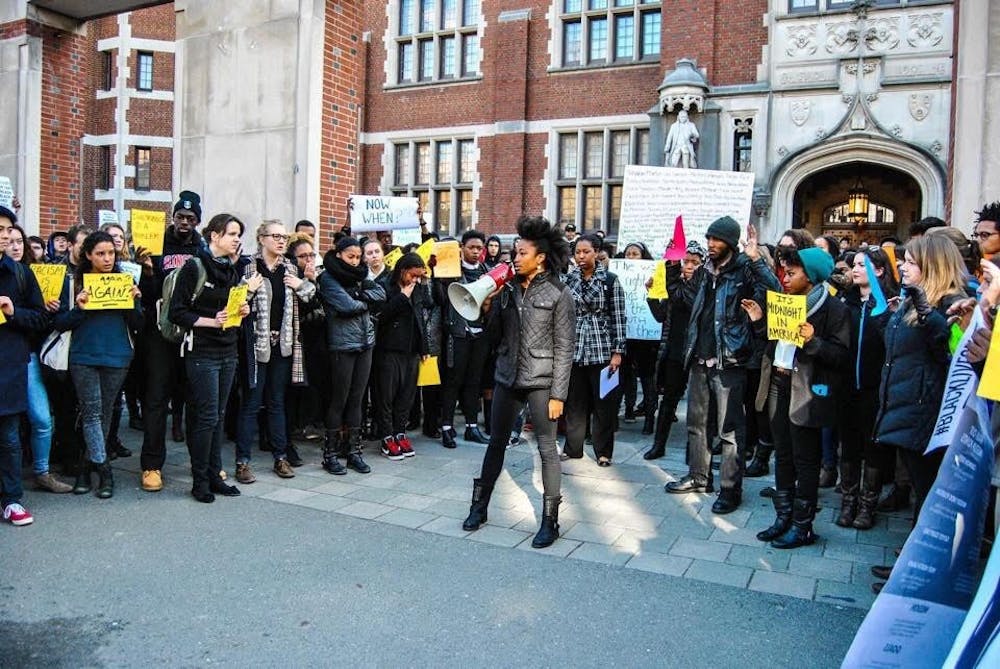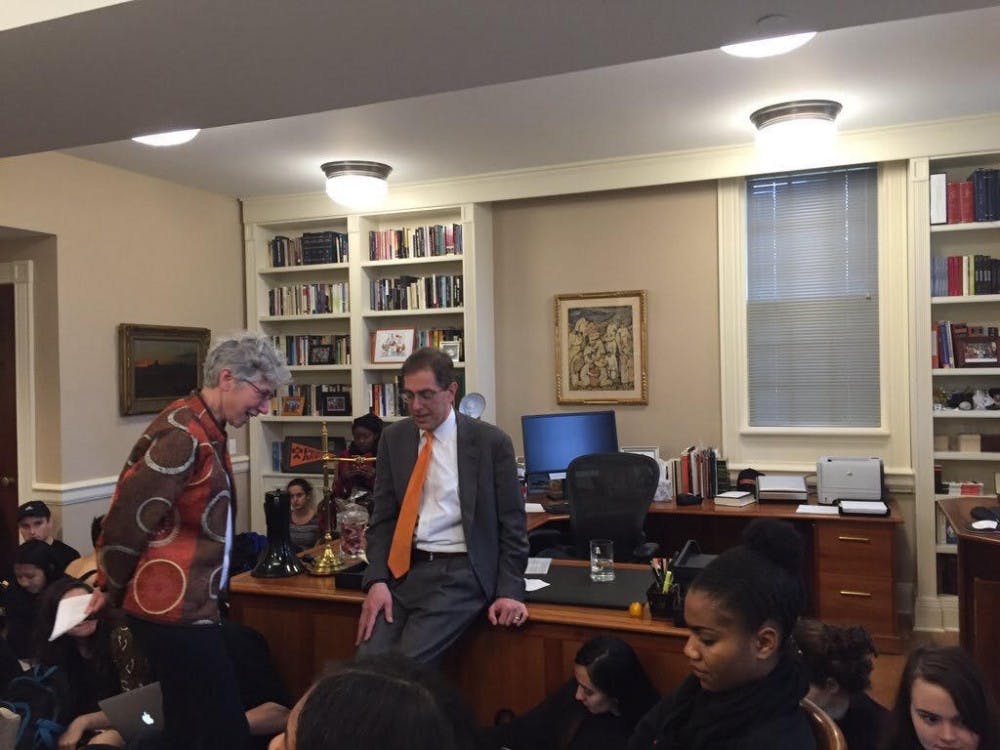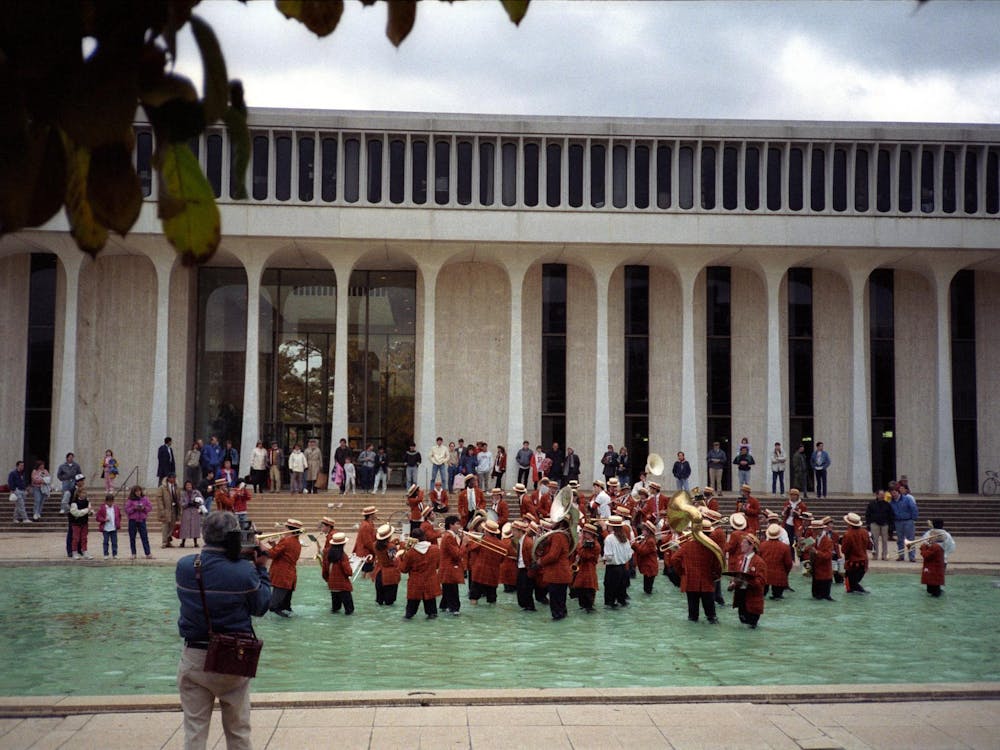At the forefront of calls for a name change to the Wilson School was the Black Justice League (BJL), a student activist organization that coordinated one of the biggest protests in Princeton history — a demonstration on the steps of Nassau Hall in 2015 followed by a 33-hour sit-in.
The protests were a major moment in the conversation that has challenged the legacy of 28th U.S. president, former University president, and avowed racist Woodrow Wilson, whose name still adorns both an academic department and a residential college on campus. The BJL advocated for renaming these buildings.
Today, the group no longer exists on campus, something co-founder Joanna Anyanwu ’15 *21 attributes to the graduation of the core organizers. She added that the University’s incentive to act was softened by the knowledge that students eventually graduate.
The BJL’s other demands included the designation of affinity spaces in the Carl A. Fields Center for Equality and Cultural Understanding, the implementation of “cultural competency training for all staff and faculty,” and that “classes on the history of marginalized peoples … be added to the list of distribution requirements.”
The organization also advocated for the establishment of an African American Studies concentration and the increased diversifying of hiring and admissions practices.
Anyanwu, herself a graduate of the Wilson School and a current MPA candidate in Public Affairs at the University and J.D. candidate at Harvard Law School, said that the group was started by students “radicalized by state violence that was occurring in the nation” during the summer of 2014, namely the deaths of Michael Brown and Eric Garner and the non-indictment of Officers Darren Wilson and Daniel Pantaleo.
“We wanted to respond in our own way to what was happening in the world,” she said. “We sort of made the connection between what was happening nationally and the experiences that we had had on campus.”
The BJL organized a protest on Prospect Avenue around Halloween in 2015. During Thanksgiving break, she said, the BJL put together a walk-out and a die-in in response to calls for walkouts across college campuses for a turnout of around 500 people outside of Frist.

According to Anyanwu, the group then shifted to focusing more on campus happenings, bringing their concerns to the administration.
They protested a talk given by Charles Murray, political scientist and author of the book “The Bell Curve,” in which he controversially argued for race-based intelligence. Another BJL-organized event was the Black Brunch, an effort to “disrupt business as usual in terms of calling attention to the fact that black people’s lives were being taken by the state,” according to Anyanwu.
Leading up to the 2015 Woodrow Wilson protests, Anyanwu said that the BJL had already been frustrated by what they perceived as a lack of substantive response from the administration to many of their demands, including “diversity in hiring faculty and student body population.”

At the same time, they saw many challenges against once-venerated Confederate figures in college campuses across the country.
“We felt a moment where the country at large was wrestling with how to dismantle the vestiges of white supremacy, and Woodrow Wilson was central to that legacy,” Anyanwu said, citing examples such as Wilson’s resegregation of the federal government and the invasion of Haiti.
The protest received its fair share of both supporters and detractors. Many of the latter made their opinions known through the social media platform YikYak, where users could create and edit discussion threads based on their locations.
“On that platform, quite a few of us, myself included, were specifically named and targeted,” Anyanwu said. “Things were said about me, that I should leave campus, and things were said to the effect that we were not grateful, spoiled, bratty ... that we were privileged kids, and what did we have to complain about?”
At the same time, though, she recounted a large number of people who were very supportive of the protest, who also sat in at Nassau and stayed for most of the time.
R.J. Paige ’17 participated in the Woodrow Wilson protests, but was not a part of the BJL due to restraints in his schedule.
Still, he said he felt a need to be part of the movement due to his own experiences as a black student on campus, especially after talking to BJL members.
“[I] felt a lot of the same kind of struggles that a lot of black students feel on campus, where there’s a lack of understanding and a lack of understanding of Princeton’s history,” Paige said. “If someone’s stepping up to try and do something about it, that’s better than nothing, in my opinion.”
Tal Fortgang ’17 said while that he fundamentally agreed with the BJL’s objective to change the name of the Wilson School, he disagreed with its reasoning.
“Princeton should not honor someone like him, who was regressive even for his time … it’s embarrassing for Princeton,” Fortgang said. “But the stated logic was the Wilson building made people feel unsafe, which I personally did not feel, and I also don’t think that is a very compelling reason for a name change … I think people are capable of separating in their minds between the name of a building and the safety associated with attending a particular organization [referring to Marx Hall].”
After the protest, the protestors and the administration reached an agreement in which, among other things, administrators agreed to discuss renaming the Wilson School and to establish four affinity spaces at the Fields Center.

Anyanwu said that the BJL was in frequent contact with the administration.
“We knew we were likely not going to reap the fruits of our labor at that time,” she said.
Anyanwu added that she saw racism as subtle but embedded in institutions like the Ivy League, especially in financial allocations and hiring and admissions practices.
She referred to the experience of former first lady Michelle Obama ’85 at the University, recounted most recently in her best-selling memoir, “Becoming.” Obama detailed her difficulties attending the University as a woman of color, recounting the predominance of white and male students, and how she often felt as though she were representing her entire race as she pursued and achieved academic success.
“I would venture to say that a lot of the concerns she had are probably still present, and these are some of the things BJL was trying to respond to,” Anyanwu said.
For Anyanwu and her peers, these problems on campus, in addition to broader societal concerns surrounding race, demanded address.
“A lot of us, we were not able to separate our academics and our other lives, and so it was important for us to be able to organize around issues that were occurring to us as black people,” Anyanwu said.
The story has been updated to correct quotes from Tal Fortgang ’17. The ‘Prince’ regrets the error.








